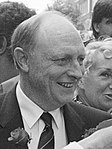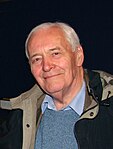Labour Party (UK) leadership election, 1988
|
|
|||||||||||||||||||
|---|---|---|---|---|---|---|---|---|---|---|---|---|---|---|---|---|---|---|---|
|
|||||||||||||||||||
|
|||||||||||||||||||
|
|||||||||||||||||||
The Labour Party leadership election of 1988 saw Tony Benn, identified with the left wing of the British Labour Party, challenge the incumbent leader Neil Kinnock.
Kinnock won the election with 89% of the vote and remained Leader until 1992, when he resigned the leadership after Labour's defeat in the 1992 general election.
Neil Kinnock became leader of the Labour Party in 1983 following the resignation of Michael Foot. The party had been moving towards the left, something that Kinnock sought to change. At the 1987 general election, Kinnock was placed front and centre of the Labour campaign, leading to claims that it was almost presidential. Margaret Thatcher's Conservative Party, seven points ahead in the polls, won the election despite a 1.2% swing to Labour.
Rumours were spreading early in 1988 that Tony Benn was planning a leadership challenge against Kinnock. The 63-year-old Benn had lost his seat in Labour's disastrous performance at the 1983 general election, only to return to parliament within a year after winning the Chesterfield by-election. During the 1960s and 1970s he had been a cabinet minister in the governments of Harold Wilson and James Callaghan. In 1981, with Labour in opposition and reeling from the centrist split from the party which led to the creation of the SDP, he had narrowly failed to defeat Denis Healey for the deputy leadership of the party.
...
Wikipedia


